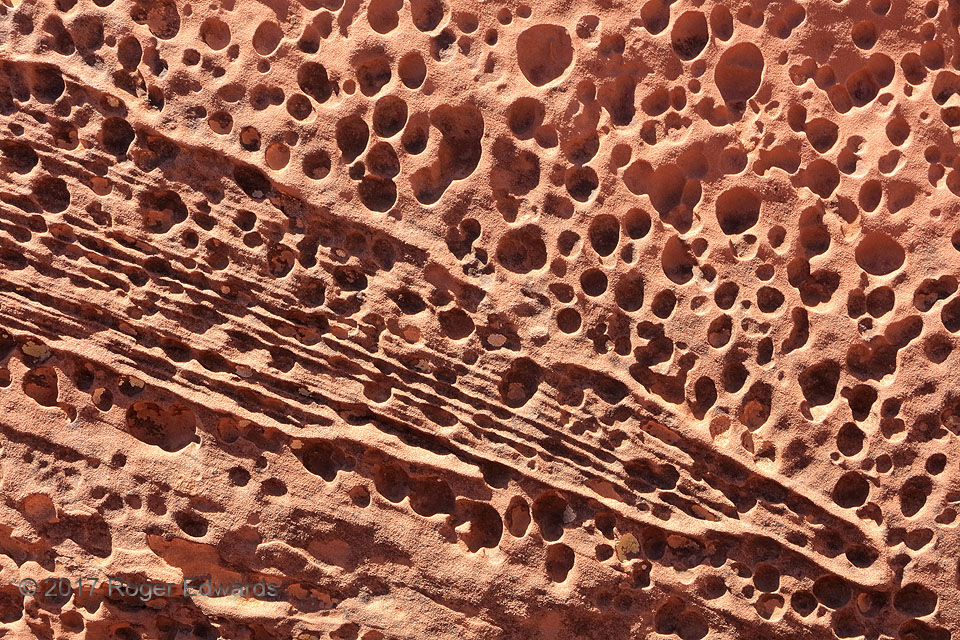 While enjoying the sweeping vistas of the famous Goosenecks on a warm midday hike, I couldn’t help but also notice small things, such as this fascinating pattern of what appears to be buckshot holes in the hard, late Triassic Wingate sandstone of Capitol Reef National Park. No, I found no spent shot inside! Instead, this rock formation commonly hosts nearly circular pits of varying sizes, most less than an inch in depth and diameter. Such weathering happens in several kinds of rocks, but most often in sandstones, in areas also having naturally occurring salts (in rocks, air and/or water). Theories vary as to what’s most important in working the sand grains loose from their cement in circular, inward-directed pitting (probably salt action), but wind abrasion, freeze-thaw cycles with water, and other forms of chemical weathering might contribute, and each is possible in the midlatitude high-desert climate of southeastern Utah. Here, the best answer to, “Why?” probably is, “all of the above”, in different levels.
7 E Torrey UT (10 Aug 17) Looking SSW
38.2986, -111.2983
While enjoying the sweeping vistas of the famous Goosenecks on a warm midday hike, I couldn’t help but also notice small things, such as this fascinating pattern of what appears to be buckshot holes in the hard, late Triassic Wingate sandstone of Capitol Reef National Park. No, I found no spent shot inside! Instead, this rock formation commonly hosts nearly circular pits of varying sizes, most less than an inch in depth and diameter. Such weathering happens in several kinds of rocks, but most often in sandstones, in areas also having naturally occurring salts (in rocks, air and/or water). Theories vary as to what’s most important in working the sand grains loose from their cement in circular, inward-directed pitting (probably salt action), but wind abrasion, freeze-thaw cycles with water, and other forms of chemical weathering might contribute, and each is possible in the midlatitude high-desert climate of southeastern Utah. Here, the best answer to, “Why?” probably is, “all of the above”, in different levels.
7 E Torrey UT (10 Aug 17) Looking SSW
38.2986, -111.2983Honeycomb Weathering, Capitol Reef
 While enjoying the sweeping vistas of the famous Goosenecks on a warm midday hike, I couldn’t help but also notice small things, such as this fascinating pattern of what appears to be buckshot holes in the hard, late Triassic Wingate sandstone of Capitol Reef National Park. No, I found no spent shot inside! Instead, this rock formation commonly hosts nearly circular pits of varying sizes, most less than an inch in depth and diameter. Such weathering happens in several kinds of rocks, but most often in sandstones, in areas also having naturally occurring salts (in rocks, air and/or water). Theories vary as to what’s most important in working the sand grains loose from their cement in circular, inward-directed pitting (probably salt action), but wind abrasion, freeze-thaw cycles with water, and other forms of chemical weathering might contribute, and each is possible in the midlatitude high-desert climate of southeastern Utah. Here, the best answer to, “Why?” probably is, “all of the above”, in different levels.
7 E Torrey UT (10 Aug 17) Looking SSW
38.2986, -111.2983
While enjoying the sweeping vistas of the famous Goosenecks on a warm midday hike, I couldn’t help but also notice small things, such as this fascinating pattern of what appears to be buckshot holes in the hard, late Triassic Wingate sandstone of Capitol Reef National Park. No, I found no spent shot inside! Instead, this rock formation commonly hosts nearly circular pits of varying sizes, most less than an inch in depth and diameter. Such weathering happens in several kinds of rocks, but most often in sandstones, in areas also having naturally occurring salts (in rocks, air and/or water). Theories vary as to what’s most important in working the sand grains loose from their cement in circular, inward-directed pitting (probably salt action), but wind abrasion, freeze-thaw cycles with water, and other forms of chemical weathering might contribute, and each is possible in the midlatitude high-desert climate of southeastern Utah. Here, the best answer to, “Why?” probably is, “all of the above”, in different levels.
7 E Torrey UT (10 Aug 17) Looking SSW
38.2986, -111.2983